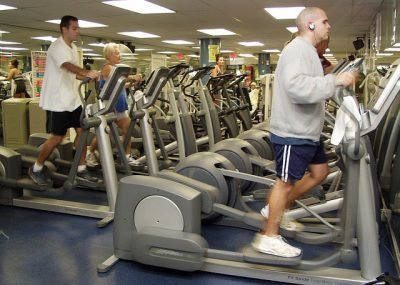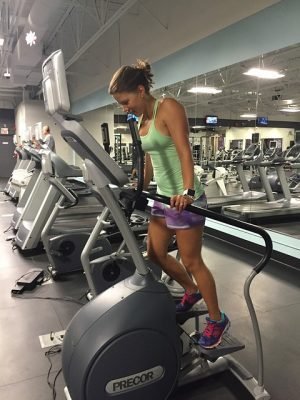 For beginners looking to gradually ease themselves into a regular workout routine or for those with sensitive, weak or injured joints who don’t want to compromise fitness because of their condition, elliptical machines are great options to have, especially when they’re readily accessible in your home. Constant contact with the pedals, the rolling motion emulating the natural movement of your joints while running or walking, keeps impact on the joints low, while still giving your lower and upper bodies a thorough workout.
For beginners looking to gradually ease themselves into a regular workout routine or for those with sensitive, weak or injured joints who don’t want to compromise fitness because of their condition, elliptical machines are great options to have, especially when they’re readily accessible in your home. Constant contact with the pedals, the rolling motion emulating the natural movement of your joints while running or walking, keeps impact on the joints low, while still giving your lower and upper bodies a thorough workout.
But what makes for a great elliptical trainer in a gym, or for the people who’ve recommended one to you, might not be suited to your needs. From budget constraints to the specific features of your machine, when considering an elliptical trainer, there are a couple of terms to understand, a few features to keep in mind so you can make the most of your workouts.
Budget
We’ll get this out of the way first – as with most things, if you’re looking at a more interactive experience with features like heart-rate monitors, incline control and presets for different workout modes, you’re going to have to pay more. The bells and whistles are great if you can afford them, but if you’re looking at a machine for only occasional use, a more pocket-friendly unit excelling in the basic core features making up a good elliptical machine will do you just fine. Note that this does not mean we encourage you to look at the cheapest option available to you – when it comes to workout equipment, we recommend paying a little extra if it ensures you better quality and effectiveness, especially in the categories we’ve broken down below.
Flywheel
 If you can’t find this word – or terms like ‘drive system’ or ‘magnetic resistance’, used synonymously – on your potential elliptical trainer’s specifications, this is a pretty big red flag. A flywheel is the component of an elliptical trainer that allows for the motion of your pedals when pressure is applied to them. Flywheels determine not just how fluid the motion of the pedals is, but the longevity of your machine, how stable it is for use, the amount of resistance you get when using the trainer, and even how heavy or bulky the machine is.
If you can’t find this word – or terms like ‘drive system’ or ‘magnetic resistance’, used synonymously – on your potential elliptical trainer’s specifications, this is a pretty big red flag. A flywheel is the component of an elliptical trainer that allows for the motion of your pedals when pressure is applied to them. Flywheels determine not just how fluid the motion of the pedals is, but the longevity of your machine, how stable it is for use, the amount of resistance you get when using the trainer, and even how heavy or bulky the machine is.
Let’s start with the latter first. When looking for an elliptical machine for the home, space is going to be one of your top considerations. Because of their more compact and lightweight builds, front drive trainers – where the flywheel is situated at the front of the machine – are more commonplace for home-use than more bulky and heavy rear drive trainers, the types that you’ll find in your gym. Both have their own sets of advantages and disadvantages – those who’ve become accustomed to the more rigorous workout they enjoy using rear drive trainers at their gym may find it difficult to adjust to the more lightweight constructs of front drive machines, though to have one in your home you’re going to have be prepared for how expensive and difficult to move they’ll prove to be. Others favor the articulating movement of some front drive trainers, the pedals pivoting with the natural movements of your joints to keep your limbs moving unnaturally, some models foldable and more portable than rear drive units.
Secondly, make sure your potential purchase lists the weight of your flywheel – the heavier the flywheel, the more fluid the movement you’ll get; jerkier pedals and arms will be counter-intuitive when the goal is low-impact workouts. You’ll find flywheel weights beginning as low as 13 pounds for home units, but if you can afford it, we’d recommend looking at higher weights, since these are directly proportional not just to the performance of your machine, but how durable and stable it is and therefore how safely you can use it.
Resistance
As we’ve previously mentioned, you’ll find some brands alluding to the magnetic resistance of their drive systems – this essentially refers to how well magnetic brakes can create resistance in conjunction to the movement of the flywheel. Larger brakes and heavier flywheels offer better resistance – in other words, they don’t immediately let you increase your speed when you move faster or immediately stop when you slow down, so you’ll have to put in more effort when you want to speed up and therefore work yourself and your muscles and joints to increases and decreases in a sustainable manner. A good range of adjustable resistance is a necessary feature for an effective elliptical trainer.
Stride length
This refers to the range and flexibility of movement your elliptical trainer allows, the distance the pedals can travel. Too low, and an individual of average height will struggle to comfortably and naturally complete the elliptical motions without the movement being restrained. In other words, your height is an important factor to guide your choice of machine – the taller you are, the longer stride lengths are suited to letting you extend your limbs thoroughly to reap the full benefits of the workout. Typically, smaller machines have shorter stride lengths, and larger ones have longer stride lengths. If you’re short on space and looking for a compact unit, make sure to check the stride length works for you before you find you’ve chosen a machine that restricts your movements and defeats its purpose.
Pedals
 As the main contact point you’ll be connected to the whole time you’re on your elliptical machine, it’s important to give this feature some thought. Pedals should be roomy enough to let you get a comfortable foothold as you work out, with traction grips to provide the necessary friction to avoid slippage. Responsive and fluid movement of pedals, as well as the articulation offered by some machines to complement the natural movements of your knee, ankle and hip joints, enhance the smoothness of your workout sessions while keeping the pressure off your joints.
As the main contact point you’ll be connected to the whole time you’re on your elliptical machine, it’s important to give this feature some thought. Pedals should be roomy enough to let you get a comfortable foothold as you work out, with traction grips to provide the necessary friction to avoid slippage. Responsive and fluid movement of pedals, as well as the articulation offered by some machines to complement the natural movements of your knee, ankle and hip joints, enhance the smoothness of your workout sessions while keeping the pressure off your joints.
Another feature to look out for is the Q-factor, or the space between the pedals. When you walk or run, your limbs center themselves, reducing the speed between your legs – therefore, pedals with tighter spacing are better suited to mimic how the body naturally moves when walking or jogging.
Console
Higher-end units may offer features like fitness apps and MP3 compatibility to jazz up your workouts, heart-rate monitors to indicate how strenuous your workout session is or the option to select or set specific workout programs, but let’s look at the features you’ll absolutely need for a properly functional elliptical. Warm-up and cool-down functions with adjustable resistance are important to let you use your machine safely, without the risk of subjecting your body to unusual and unnecessary strains or risking injury. Controls should be intuitive and easy to read, with screens displaying the options you have selected, the degree of resistance, the program you’re currently using, and so on.
Warranties
It’s extremely important to read the fine print, to make sure that if you run into any trouble with your machine, you’re covered by the company for a replacement or repair. Make sure the warranty covers you for a decent period of time, and that it encompasses the entire machine rather than parts of it.